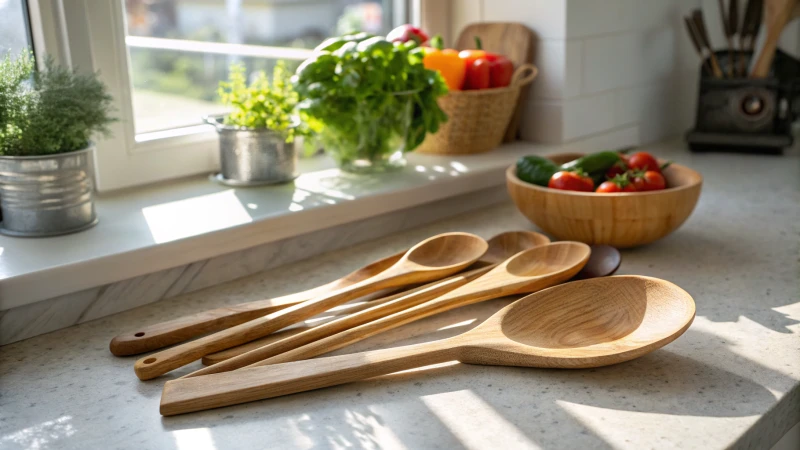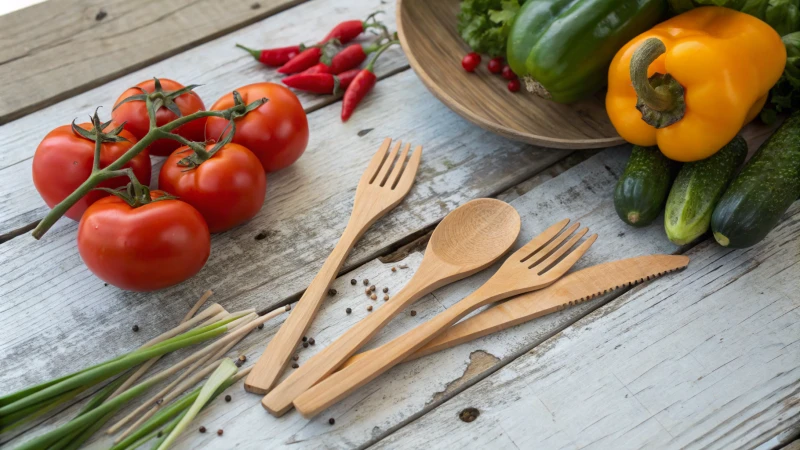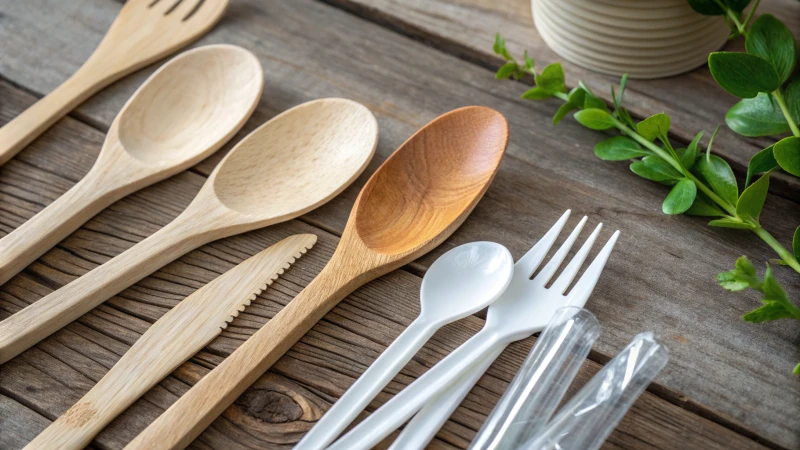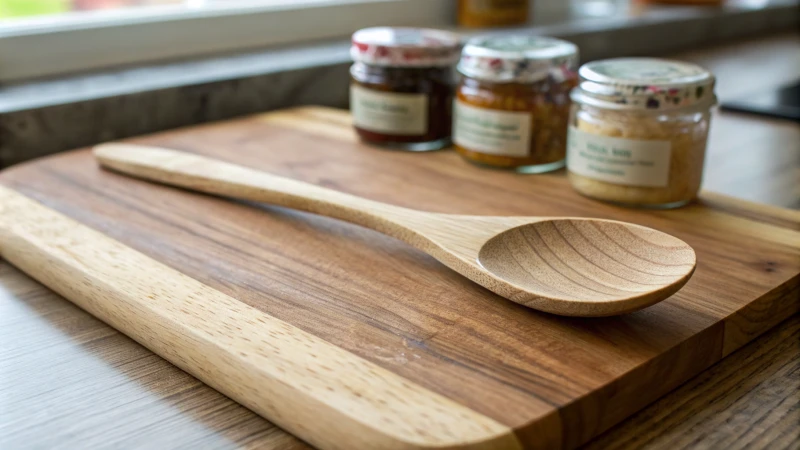
Do you ever think about how safe disposable wooden spoons are while cooking your favorite meal? Many others really wonder about it too!
Disposable wooden spoons are probably safe for health when crafted from certified materials. Proper processing is essential. These spoons must follow food safety standards. Harmful coatings should be avoided to protect users. Thorough cleaning prevents contamination. Clean spoons are better.
Let's explore the world of disposable wooden spoons. I recall the first time I chose wooden spoons over plastic ones. I felt a wave of guilt disappear as I embraced an eco-friendly option. A worry about their safety then appeared. I wondered if these spoons were really safe to use. My research taught me that high-quality, certified materials make a difference. Careful processing makes these spoons safe. It's essential to find spoons that meet food safety standards. These spoons must avoid harmful coatings. Thorough cleaning of the spoons helps avoid contamination. Clean spoons stay safe.
Disposable wooden spoons are safe if made from certified materials.True
Wooden spoons that meet food safety standards are considered safe for health.
All disposable wooden spoons are harmful to your health.False
Not all wooden spoons are harmful; safety depends on materials and processing.
What Are the Key Health Safety Standards for Wooden Cutlery?
When I first entered the world of wooden cutlery, I noticed how important health safety rules are. These rules protect our well-being. Let's explore what you probably need to know to keep your meals safe and enjoyable!
Select certified woods, such as birch or bamboo, for safe wooden cutlery. Avoid harmful chemicals during processing. Conduct tests to check if cutlery is safe for food contact. Store and clean cutlery properly to keep it resistant to germs. Safety is really important.

Key Health Safety Standards for Wooden Cutlery
Health standards for wooden cutlery focus on several main areas. The first area is choosing the right material. This involves using certified woods like birch and bamboo. Avoiding harmful chemical processing is also important. Safe cutlery does not use bad substances. The cutlery should stay safe when in contact with food. Good cutlery avoids letting harmful things move into the food. Also, keeping cutlery resistant to bacteria means storing and cleaning it properly. Following these standards protects us. It also lets us enjoy meals with sustainable choices.
Understanding Material Selection
The choice of wood for cutlery matters a lot. This choice is like picking the right ingredient for a dish. Birch and bamboo are eco-friendly. They have natural antibacterial properties, which gives peace of mind when cooking and serving.
However, caution is warranted:
- Some woods might contain substances that trigger allergies.
- Unverified wood can have chemical residues, such as pesticides sneaking into meals.
Example: Choosing FSC-certified birch supports sustainable forests, making a big difference! To further explore this, check out sustainable sourcing practices1.
Chemical Processing Standards
Processing methods for wooden cutlery matter greatly. Premium products avoid harsh chemicals like bleach and instead utilize food-grade coatings, which feel safer.
| Processing Method | Safety Level | Examples |
|---|---|---|
| Bleach | Low | Common in cheaper alternatives |
| Food-grade natural coatings | High | Beeswax or plant oils |
Improper heat treatment leads to danger. Controlled heat during sterilization is crucial; without it, products degrade, which nobody wants.
For more on food-grade standards, visit food safety regulations2.
Ensuring Food Contact Safety
Wooden cutlery undergoes migration testing to guarantee safety for food contact. This testing proves no harmful substances leach out during use under high temperatures or acidic conditions.
Example: Products passing ISO 22000 and EU 10/2011 standards ensure safety even under tough conditions when serving hot meals.
Natural coatings are significant; poor products might have additives that degrade and release harmful substances into food. Explore this further by checking out migration testing protocols.
Microbial Resistance and Hygiene Practices
Wooden cutlery has natural antibacterial properties due to its porous structure that traps bacteria, slowing their growth. Proper cleaning is key to preventing mold development, especially in humid environments.
| Storage Solution | Effectiveness |
|---|---|
| Sealed packaging | Excellent |
| Moisture-proof systems | Good |
Using plant extracts in surface treatment can really improve effectiveness against microbes; learn more about hygiene standards by visiting cleaning and storage practices3.
Application Scenarios and Special Considerations
Wooden cutlery is useful in many situations but specific conditions require additional attention:
- High-Temperature and Acidic Foods: Cutlery must endure heat and acidity to stop warping, especially with hot soups.
- Children and Vulnerable Populations: Hygiene standards must be higher when feeding vulnerable people like infants.
To optimize wooden cutlery for these scenarios, consider designing products that withstand high temperatures while ensuring they are safe for kids.
Birch and bamboo are the safest woods for cutlery.True
Birch and bamboo possess natural antibacterial properties, making them ideal choices for wooden cutlery. They are also eco-friendly and sustainable.
Bleach is commonly used in premium wooden cutlery processing.False
Premium wooden cutlery avoids harsh chemicals like bleach, favoring food-grade coatings instead to ensure safety and quality.
How Do Disposable Wooden Spoons Compare to Plastic Utensils?
Do you often feel confused about choosing wooden or plastic utensils for your next party? Let's explore the feelings and practical sides of these two options. They are really important for our health and the Earth!
**Wooden spoons are a better choice for the environment compared to plastic utensils. Wooden spoons break down naturally and are biodegradable. Plastic utensils stay in landfills for hundreds of years, harming the planet. Wooden spoons come from birch or bamboo, which are renewable resources. Plastic utensils are made from fossil fuels like polypropylene or polystyrene.
Material Composition and Environmental Impact
Materials used in disposable utensils affect the environment. Wooden spoons decompose in a few months when composted. Plastic utensils add waste to landfills and take a long time to disappear. This difference makes me choose wooden spoons for events. Every small effort helps our planet.
Health and Safety Considerations
Health is important when I choose utensils. Wooden spoons resist bacteria because they are porous. They need good cleaning, especially in damp places. Plastic utensils might leak harmful chemicals into food, especially with heat or acids. This risk made me think twice about what I serve to others.
For more information on health safety, check safety standards for utensils.
Durability and Practical Use
Durability is crucial. Wooden spoons withstand high temperatures well and are great for cooking. They need gentle care to avoid cracking. Plastic utensils are stronger for one-time use, but they can melt if exposed to heat.
Wooden Spoons꞉ Best for cooking and serving; may break over time.
Plastic Utensils꞉ Tougher for single-use; can melt in high heat.
Cost and Accessibility
Cost often influences my choice. Plastic utensils are cheaper and easy to find, suitable for big events. Wooden spoons cost more, but they look nice and are better for the environment. I find value in spending a bit more for sustainability.
For economic eco-friendly options, see affordable sustainable products.
User Considerations and Preferences
Choosing between wooden and plastic depends on personal taste and purpose. Some caterers use wooden spoons for their elegant, eco-friendly style. Fast-food places pick plastic for ease of use. Knowing what people care about has become vital for me.
For more on this topic, check catering trends in utensil choices.
In summary, both wooden spoons and plastic utensils have benefits. I choose based on sustainability, health and durability. It's about making better choices for a healthier planet. Let's save the earth for future generations.**

Deciding between disposable wooden spoons and plastic utensils feels overwhelming. It is also a journey of discovery. I recall when I hosted a picnic with friends. I felt excited to use eco-friendly wooden cutlery. It felt good to know that I chose what matched my values. I also needed to think about practicality and budget. Here is what I learned!
Material Composition and Environmental Impact
When comparing disposable wooden spoons to plastic utensils, the first consideration is the material used. Wooden spoons are typically made from birch or bamboo, both of which are renewable resources and biodegradable. In contrast, most plastic utensils are made from polypropylene or polystyrene, materials derived from fossil fuels that contribute to environmental pollution.
- Wooden Spoons: Biodegradable within a few months in a composting environment.
- Plastic Utensils: Can take hundreds of years to decompose, contributing significantly to landfill waste.
For further insights on this aspect, you can check out environmental impact of materials4.
Health and Safety Considerations
Health implications are crucial when choosing between wooden and plastic utensils. Wooden spoons have natural antibacterial properties due to their porous structure, which can inhibit the growth of bacteria if properly maintained. However, they require thorough cleaning to prevent mold growth, especially in humid environments.
On the other hand, plastic utensils can leach harmful chemicals, particularly when exposed to heat or acidic foods. This can pose health risks, making it essential for consumers to consider the safety certifications of the products they choose.
| Property | Wooden Spoons | Plastic Utensils |
|---|---|---|
| Biodegradability | Yes (months) | No (hundreds of years) |
| Antibacterial | Natural | None |
| Chemical Safety | Generally safe if untreated | Can leach harmful chemicals |
To explore more on health safety regulations, visit safety standards for utensils5.
Durability and Practical Use
Durability is another critical factor in this comparison. While wooden spoons can withstand high temperatures and are suitable for hot foods, they may not hold up as well in extended exposure to moisture without proper care. Plastic utensils are generally more durable in terms of water resistance and can be more flexible in various temperature conditions.
- Wooden Spoons: Ideal for serving and cooking; may splinter or crack with wear.
- Plastic Utensils: More durable for single-use scenarios; however, they may melt in high temperatures.
Cost and Accessibility
When considering cost, plastic utensils tend to be cheaper upfront and are widely available, making them a go-to option for events with large numbers of guests. In contrast, while wooden spoons may be more expensive per unit, their sustainability and aesthetic appeal can justify the cost for eco-conscious consumers.
| Cost Comparison | Wooden Spoons | Plastic Utensils |
|---|---|---|
| Average Price/Unit | Higher | Lower |
| Long-term Investment | Sustainable choice | Single-use disposable |
For tips on sourcing cost-effective eco-friendly options, check affordable sustainable products6.
User Considerations and Preferences
Finally, the choice between wooden and plastic utensils often comes down to personal preference and specific use cases. For instance, caterers and event planners focusing on a sustainable image may prefer wooden spoons for their aesthetic and environmental benefits. In contrast, fast-food chains may opt for plastic utensils due to their lower cost and convenience.
Understanding your audience's values and preferences is essential in making the right choice. For further guidance on catering options, you might want to look at catering trends in utensil choices7.
Wooden spoons are biodegradable, unlike plastic utensils.True
Wooden spoons decompose within months, while plastic can take centuries to break down, making them more environmentally friendly.
Plastic utensils can leach harmful chemicals when heated.True
Exposure to heat or acidic foods can cause plastic utensils to release toxic substances, posing health risks.
What Materials Should You Look for When Choosing Wooden Cutlery?
Have you ever thought about the wooden cutlery in your kitchen? The right materials are very important. They influence durability, safety and the environment. Let's explore what you should consider!
Select wooden cutlery made from eco-friendly materials such as birch and bamboo. Avoid items with harmful chemical treatments. Pick products that meet safety standards. This helps in providing durability and safety.

1. Material Type
Choosing the right wood for cutlery is important. Popular choices include birch and bamboo, both known for their eco-friendly and antibacterial properties.
| Wood Type | Features | Benefits |
|---|---|---|
| Birch | Durable, fine grain | Resists splintering; smooth texture |
| Bamboo | Fast-growing, lightweight | Strong yet flexible; naturally antibacterial |
When I shop, I seek products using materials with FSC-certification8. This choice supports responsible forestry practices and gives me peace of mind.
2. Chemical Treatments
I discovered that not all wooden cutlery is equal. Avoid wooden cutlery that undergoes harsh chemical processing. Now, I choose products with food-safe coatings like beeswax or plant oils, which are safer for my family and kinder to the environment.
Examples of Coatings:
- Beeswax
- Plant oils
- Water-based finishes
These coatings enhance durability while keeping harmful substances away from my meals. Products that avoid bleach are preferred as they maintain the wood's integrity and natural properties.
3. Allergens and Safety Standards
Awareness of possible allergens in wooden cutlery is very important. Some woods have natural resins or tannins that could trigger allergic reactions in sensitive individuals. Always check for certificates like ISO 22000 or EU 10/2011 for food safety. For allergy safety, I select hypoallergenic wood types or those labeled as safe.
Additionally, thorough testing for migration of substances9 under various conditions ensures that no harmful chemicals leach into food.
4. Longevity and Maintenance
Cutlery longevity depends on material quality and processing methods. Look for cutlery treated with heat to prevent cracks and damage over time.
Maintenance Tips:
- Hand wash rather than machine wash to prolong life.
- Do not soak in water for long periods.
- Occasionally apply natural oils to keep wood in good shape.
With the right care, wooden cutlery lasts longer, enhancing its eco-friendly appeal!
Bamboo is a lightweight and naturally antibacterial wood.True
Bamboo's properties make it an ideal choice for wooden cutlery, being lightweight and having natural antibacterial qualities.
Bleach-treated wooden cutlery is safer for food use.False
Bleach can compromise wood integrity; thus, avoiding bleach-treated cutlery is safer for health and food safety.
How Can You Keep Disposable Wooden Spoons Clean and Safe?
I want to share my journey in keeping disposable wooden spoons clean. It's not only about being good for the environment. It is about serving food safely. Come along as I find smart ways to keep these lovely utensils fresh and hygienic.
Check disposable wooden spoons before using them. Store them in dry places. Avoid soaking them in water. Use food-safe coatings on these utensils. High-temperature environments need special attention. Vulnerable individuals must be extra cautious. Safety and cleanliness are really important.

Understanding the Importance of Hygiene in Disposable Wooden Spoons
Maintaining hygiene with disposable wooden spoons is crucial for food safety. Unlike plastic utensils, which can leach harmful chemicals, wooden spoons can provide a more natural and eco-friendly option. However, they require specific attention to ensure they remain safe for use.
Key considerations include:
- Material Quality: Ensure that the wooden spoons are made from high-quality, food-grade materials like certified birch or bamboo, as these are naturally antibacterial.
- Proper Storage: Store wooden utensils in a dry place to avoid mold growth. Sealed packaging can significantly reduce the risk of contamination.
Cleaning and Care Practices
Although disposable wooden spoons are designed for single-use, ensuring they are clean and free of contaminants is vital. Here are some practical steps:
| Practice | Description |
|---|---|
| Inspect Before Use | Check for any visible signs of damage or contamination. |
| Avoid Soaking | Do not soak wooden spoons in water; this can cause them to warp. |
| Wipe with a Clean Cloth | Use a clean cloth to wipe the spoon if it comes into contact with any food before disposal. |
| Use Food-Safe Coatings | Ensure any coatings used on wooden spoons are natural and safe. |
Best Practices for Specific Scenarios
Different environments may require specific practices to maintain hygiene effectively:
1. High-Temperature Environments
In scenarios where wooden spoons come into contact with hot foods:
- Select Heat-Resistant Products: Choose spoons that can withstand high temperatures to prevent breakdown.
- Monitor Usage Time: Limit exposure to high heat to maintain the integrity of the spoon and avoid degradation.
2. Children and Immunocompromised Individuals
When using wooden spoons for children or those with compromised immune systems:
- Opt for Child-Safe Designs: Ensure that the size and shape are suitable for children to prevent choking hazards.
- Focus on Extreme Cleanliness: More stringent hygiene practices should be applied, such as using individual packaging for disposable options.
Summary of Hygiene Tips
To encapsulate the best practices for maintaining hygiene with disposable wooden spoons, here’s a quick summary:
- Choose Quality Materials: Always opt for FSC-certified wood to minimize chemical exposure.
- Store Properly: Keep wooden spoons dry and packaged appropriately to avoid microbial growth.
- Handle with Care: Use appropriate methods to clean and inspect the utensils before use.
For more detailed insights on the hygiene practices surrounding disposable wooden cutlery, consider exploring resources that delve deeper into food safety standards best practices10 for disposable utensils, or eco-friendly options that prioritize health alongside sustainability.
Disposable wooden spoons are safer than plastic for food.True
Wooden spoons do not leach harmful chemicals, making them a safer choice for food contact compared to plastic utensils.
Soaking wooden spoons is essential for hygiene maintenance.False
Soaking can warp wooden spoons and promote contamination, so it should be avoided to maintain hygiene.
Conclusion
Disposable wooden spoons are safe if crafted from certified materials and properly processed. They offer an eco-friendly alternative to plastic while ensuring food safety.
-
This link provides detailed insights into health safety standards for wooden cutlery, ensuring you're informed about best practices and regulations. ↩
-
Discover food safety regulations related to wooden utensils to ensure compliance in your kitchen or business. ↩
-
Learn effective cleaning practices for wooden cutlery to maintain hygiene and safety in food service. ↩
-
This link provides valuable insights into the environmental impact of different materials used in disposable cutlery. ↩
-
Learn about essential safety standards that ensure food safety when using disposable utensils. ↩
-
Explore affordable options for eco-friendly disposable products that don't compromise on quality. ↩
-
Discover current catering trends regarding utensil choices and consumer preferences for events. ↩
-
Discover expert insights on the best materials for wooden cutlery to ensure quality and sustainability. ↩
-
Learn about food safety standards related to wooden cutlery and how to select safe options. ↩
-
Discover essential tips on keeping your disposable wooden spoons hygienic and safe for use. This guide offers practical advice for both home and professional settings. ↩

